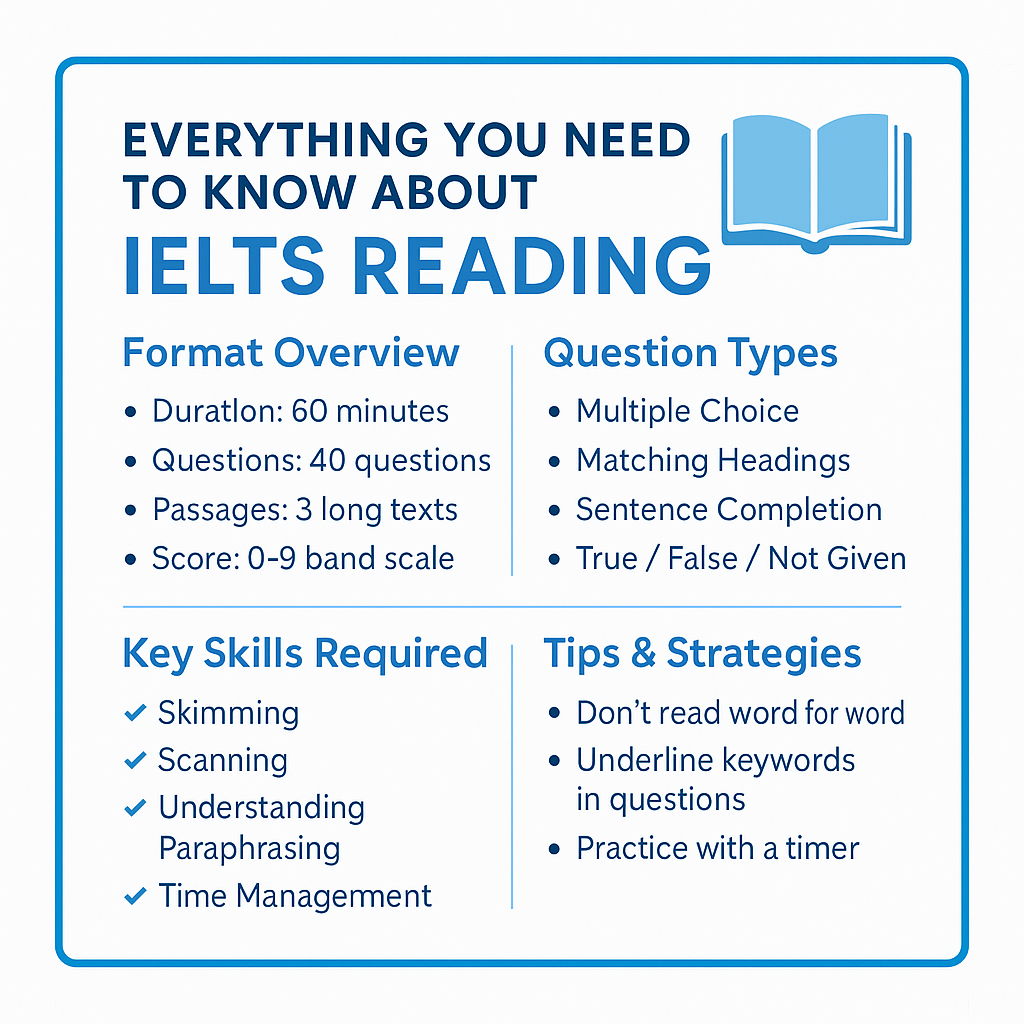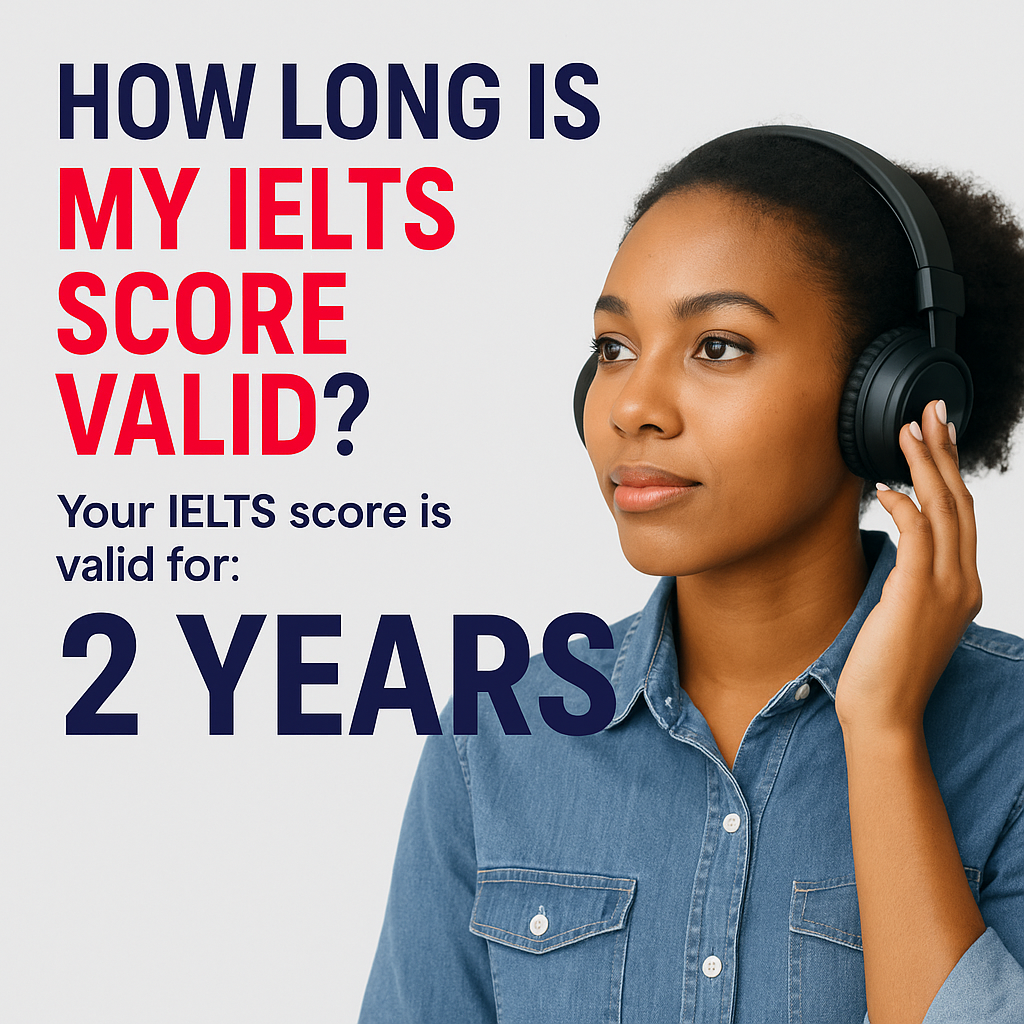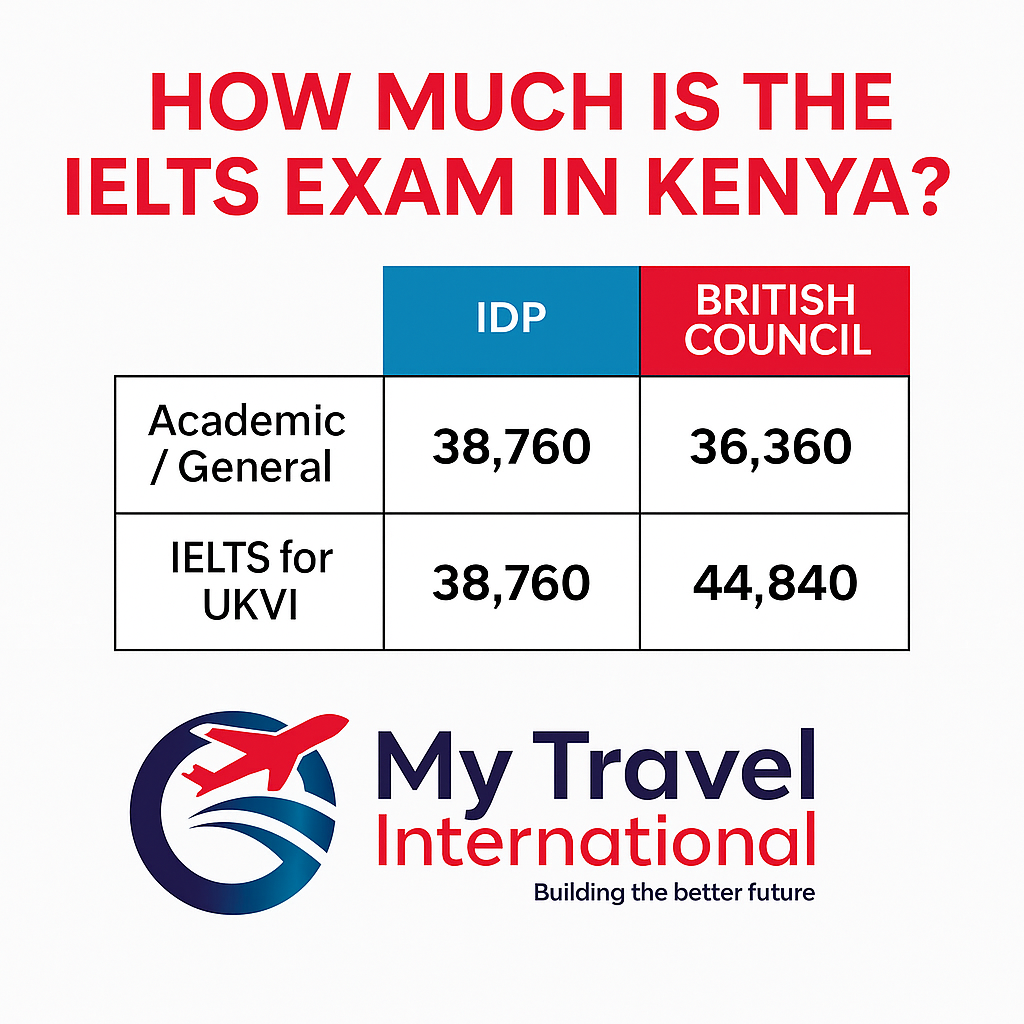What is IELTS?
IELTS is an international test designed to measure your English language ability in four key skills:
Listening
Reading
Writing
Speaking
It is jointly managed by the British Council, IDP: IELTS Australia, and Cambridge Assessment English.
The IELTS Listening Test is the first part of the IELTS exam and plays a key role in determining your overall band score. Whether you’re taking the Academic or General Training version, the listening section is the same for all candidates. Here’s a complete guide to help you understand the structure, strategies, and preparation tips for success.
Test Overview
Duration: 30 minutes (+10 minutes transfer time if paper-based)
Format: 4 recordings, 40 questions
Skills Tested: Listening for gist, detail, opinions, main ideas, and specific information.
Structure of the Listening Test
Section 1: Everyday Conversation
A dialogue between two people in a social context (e.g., booking a hotel or registering for a course).
Tests your ability to understand factual, everyday information.
Section 2: Monologue in Social Context
A single speaker talking about everyday situations (e.g., a guided tour or radio broadcast).
Focuses on following instructions or identifying main ideas.
Section 3: Academic Discussion
A conversation between 2–4 people (students and/or tutor) in an academic or training context.
Tests understanding of opinions, arguments, and agreements.
Section 4: Academic Lecture
A university-style lecture on an academic subject.
Usually the most challenging part because it involves complex vocabulary and ideas.
Question Types
You will encounter a variety of question formats, such as:
Multiple choice
Matching
Plan, map, or diagram labeling
Form, note, table, or summary completion
Sentence completion
Short-answer questions
Scoring
40 questions = 40 marks
Scores are converted into a band score from Band 1 to 9.
Example:
39–40 correct = Band 9
30 correct = Band 7
23 correct = Band 6
Key Challenges in Listening
Accents: IELTS includes British, Australian, American, and other English accents.
One-time playback: Recordings are played only once.
Distractors: Wrong answers are often mentioned before the correct one.
Spelling & grammar: Incorrect spelling leads to lost marks.
Tips for Success
Read questions before the audio starts – anticipate answers.
Focus on keywords – listen for synonyms and paraphrases.
Practice different accents – watch English movies, listen to BBC podcasts, and TED talks.
Take notes while listening – capture key details.
Check spelling and grammar – even small mistakes cost marks.
Stay calm if you miss an answer – move on quickly to the next.
The IELTS Listening test can seem challenging, but with the right strategies and consistent practice, you can improve significantly. It’s not just about hearing words — it’s about understanding meaning, context, and details.
At My Travel International, we provide mock listening tests, practice sessions, and expert feedback to help candidates sharpen their listening skills and achieve higher band scores.
The IELTS Reading Test is one of the most important sections of the exam. It assesses your ability to read and understand English texts in different contexts, whether for everyday use (General Training) or academic study (Academic IELTS). Let’s break it down step by step so you know exactly what to expect.
Test Overview
Duration: 60 minutes (no extra transfer time)
Format: 3 sections, 40 questions
Skills Tested: Reading for gist, detail, opinions, facts, and logical argument.
Differences Between Academic & General Training
Academic Reading
Texts are taken from books, journals, magazines, and newspapers.
Topics are academic but accessible to non-specialists.
Suitable for students applying to universities or professional registration.
General Training Reading
Texts are based on everyday life, work, and community contexts.
Section 1: Short texts (e.g., advertisements, notices, schedules).
Section 2: Work-related texts (e.g., contracts, instructions).
Section 3: One longer, general-interest text.
Structure of the Reading Test
40 questions in total spread across three sections.
The texts get progressively more difficult.
Question Types
You’ll encounter a wide variety of question types, including:
Multiple choice
Matching headings or information
True / False / Not Given
Yes / No / Not Given
Sentence completion
Summary, note, table, or flow-chart completion
Diagram labeling
Short-answer questions
Scoring
40 questions = 40 marks
Scores are converted to IELTS band scores.
Academic and General Training have different score conversions.
For example:
Academic: 30/40 ≈ Band 7
General Training: 30/40 ≈ Band 6
Key Challenges in Reading
Time pressure: 60 minutes for 3 sections, with no extra time to transfer answers.
Complex vocabulary: Academic texts may include advanced terminology.
Tricky question types: Especially True/False/Not Given and Yes/No/Not Given.
Synonyms and paraphrasing: Questions are rarely word-for-word from the text.
Tips for Success
Practice skimming and scanning – don’t try to read every word in detail.
Highlight keywords in the question and search for them in the text.
Manage your time – aim for about 20 minutes per section.
Guess if unsure – no negative marking, so never leave answers blank.
Improve vocabulary – especially academic and formal English.
Practice different question types – to build speed and accuracy.
The IELTS Reading Test is more about strategy and practice than just language ability. By improving your time management, skimming skills, and familiarity with question types, you can significantly raise your band score.
The IELTS Writing Test is one of the most challenging sections of the exam for many candidates. It requires not only strong English skills but also the ability to organize ideas clearly, follow instructions, and manage time effectively. Here’s a full guide to help you understand the format, scoring, and strategies for success.
Test Overview
Duration: 60 minutes
Format: 2 tasks (Task 1 & Task 2)
Scoring: Task 2 carries double the weight of Task 1 in your final score.
Academic vs. General Training
Academic IELTS Writing
Task 1: Describe, summarize, or explain visual data (graphs, charts, tables, or diagrams). You must write at least 150 words.
Task 2: Write an essay responding to a point of view, argument, or problem. Minimum 250 words.
General Training IELTS Writing
Task 1: Write a letter (formal, semi-formal, or informal) based on a given situation. At least 150 words.
Task 2: Same essay format as Academic, but topics are more general. At least 250 words.
IELTS Writing Assessment Criteria
Examiners mark your writing based on four key criteria:
Task Achievement (Task 1) / Task Response (Task 2): Did you answer the question properly and cover all parts of the task?
Coherence and Cohesion: Is your writing logical, well-organized, and connected with linking words?
Lexical Resource: Do you use a wide range of vocabulary accurately and appropriately?
Grammatical Range and Accuracy: Do you use varied grammar structures correctly?
Each criterion contributes 25% to your band score.
Common Challenges in Writing
Writing fewer words than required (under 150/250 words).
Using spoken language instead of formal academic style.
Weak essay structure (no clear introduction, body, conclusion).
Repetition of vocabulary and ideas.
Poor time management (spending too long on Task 1 and rushing Task 2).
Tips for IELTS Writing Success
Plan before you write – spend 3–5 minutes outlining your ideas.
Always answer the whole question – avoid going off-topic.
Use linking words (however, moreover, in addition, on the other hand) to connect ideas.
Practice academic vocabulary for describing trends, opinions, and arguments.
Focus on grammar accuracy – fewer mistakes score higher than complex but incorrect sentences.
Manage your time – about 20 minutes for Task 1, 40 minutes for Task 2.
Practice under exam conditions – write essays regularly within 60 minutes.
The IELTS Writing Test is all about clarity, structure, and precision. By practicing different question types, learning how to structure essays and reports, and improving your vocabulary and grammar, you can achieve a strong band score.
The IELTS Speaking Test is often considered the most interactive and natural part of the exam. It’s designed to assess your ability to communicate effectively in English, just as you would in real-life situations. Unlike the other sections, the speaking test is conducted face-to-face with an examiner, giving you the chance to demonstrate fluency, vocabulary, and confidence.
Test Overview
Duration: 11–14 minutes
Format: Face-to-face interview with a certified examiner
Skills Tested: Fluency, coherence, vocabulary, grammar, and pronunciation
Structure of the Speaking Test
Part 1: Introduction and Interview (4–5 minutes)
General questions about yourself, your home, family, studies, hobbies, and everyday topics.
Purpose: To make you feel comfortable and test your ability to speak about familiar topics.
Part 2: Individual Long Turn (3–4 minutes)
You’ll receive a task card with a topic and 3–4 bullet points to guide your response.
You have 1 minute to prepare and then must speak for up to 2 minutes.
Afterward, the examiner may ask 1–2 follow-up questions.
Part 3: Two-Way Discussion (4–5 minutes)
A deeper discussion with the examiner related to Part 2’s topic.
Focuses on expressing opinions, analyzing issues, and discussing abstract ideas.
Assessment Criteria
The examiner scores you on:
Fluency and Coherence – Ability to speak smoothly and logically.
Lexical Resource – Range and accuracy of vocabulary.
Grammatical Range and Accuracy – Variety and correctness of grammar.
Pronunciation – Clarity, intonation, and natural speech.
Each area contributes 25% to your final speaking band score.
Common Challenges in IELTS Speaking
Speaking too little or giving very short answers.
Overthinking and pausing too often.
Memorized answers that sound unnatural.
Mispronunciation or a very strong accent that affects clarity.
Running out of ideas during Part 2.
Tips for Success
Practice speaking daily – with friends, in study groups, or even recording yourself.
Don’t memorize answers – examiners can tell if you’re reciting.
Expand your answers – give examples, reasons, or stories.
Use linking words – (for example, actually, on the other hand, as a result).
Work on pronunciation – stress, rhythm, and intonation matter more than accent.
Stay calm and confident – treat it like a natural conversation.
The IELTS Speaking Test is your chance to shine by showing how well you can use English in real-life situations. It’s not about perfect grammar — it’s about communication, clarity, and confidence. With regular practice and the right strategies, you can boost your band score significantly.
At My Travel International, we provide one-on-one speaking practice, mock interviews, and expert feedback to help you gain confidence and perform at your best on test day.
Types of IELTS Tests
1. IELTS Academic
Designed for students applying to universities, colleges, or professional registration.
Tests your ability to handle academic English in lectures, reading journals, and essay writing.
2. IELTS General Training
Suitable for those migrating for work, training programs, or secondary education.
Focuses on everyday English used in social and workplace contexts.
IELTS Test Format
Listening (30 minutes): Four recordings of native English speakers, with 40 questions.
Reading (60 minutes): 3 sections with 40 questions. Academic version uses academic texts, while General Training uses everyday texts.
Writing (60 minutes): 2 tasks. Academic requires describing a graph or chart (Task 1) and essay writing (Task 2). General Training requires letter writing (Task 1) and essay writing (Task 2).
Speaking (11–14 minutes): Face-to-face interview with an examiner in three parts: introduction, individual long turn, and discussion.
Scoring System
IELTS uses a 9-band scoring system.
Scores range from Band 1 (non-user) to Band 9 (expert user).
Most universities and immigration bodies require a minimum overall band score of 6.0–7.5, depending on the purpose.
Why Choose IELTS?
Globally recognized – accepted by over 11,000 organizations worldwide.
Accurate assessment – measures real-life communication skills.
Flexible test options – available in paper-based, computer-based, and online formats.
Migration opportunities – IELTS is trusted for visa applications in countries like Australia, Canada, the UK, and New Zealand.
Preparation Tips for IELTS Success
Practice with sample test papers.
Improve vocabulary and grammar through daily reading.
Listen to podcasts, English news, and practice note-taking.
Speak English daily with friends or join speaking clubs.
Take mock tests under timed conditions to improve speed.
Final Thoughts
IELTS is more than just an exam — it’s your gateway to global education, work, and migration opportunities. With the right preparation and guidance, achieving a high band score is possible.
At My Travel International, we help candidates prepare effectively for IELTS with personalized coaching, speaking practice, and exam strategies to boost confidence and maximize results.



